Harnessing the Healing Power of Plant Medicines
Throughout human history, plant medicines have played an essential role in treating ailments and promoting health. Modern scientific research is increasingly validating the traditional uses of plants, uncovering the specific constituents responsible for their therapeutic effects. However, plants are more than a single ingredient, and thus their value for us is far greater than the benefit of any one isolated part. This article delves into how plant medicines enhance our natural healing capabilities, focusing on the active compounds within these plants, while also recognizing the therapeutic synergy between plant constituents.
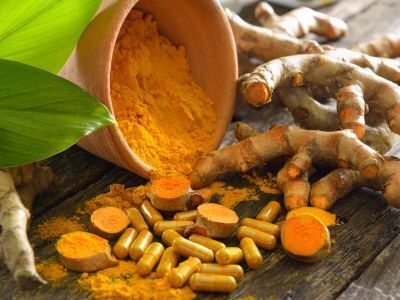
The Therapeutic Power of Plant Constituents
Plants produce a wide array of bioactive compounds that contribute to their medicinal properties. Some examples of these constituent categories include alkaloids, flavonoids, terpenoids, and phenolic acids, each offering unique health benefits. Below, we explore some of these compounds and their roles in enhancing our natural healing processes.
Curcumin in Turmeric
Turmeric (Curcuma longa) has been used in traditional medicine for centuries, primarily for its anti-inflammatory and antioxidant properties. One of the primary active compounds in turmeric that has gained a lot of recent focus is curcumin, a polyphenol with potent biological effects. However, there are many curcuminoids and they likely all provide health benefits. Two examples of curcumin benefits include:
- Anti-inflammatory Effects: Curcumin has been shown to inhibit the activity of nuclear factor-kappa B (NF-κB), a protein complex that regulates inflammation. By suppressing NF-κB, curcumin reduces the production of pro-inflammatory cytokines, thereby alleviating inflammation and pain (Aggarwal et al., 2007).
- Antioxidant Properties: Curcumin also acts as a scavenger of free radicals, protecting cells from oxidative damage. It enhances the activity of antioxidant enzymes such as superoxide dismutase and catalase (Menon & Sudheer, 2007).
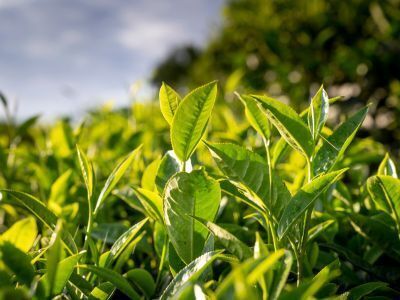
Epigallocatechin Gallate (EGCG) in Green Tea
Green tea (Camellia sinensis) is renowned for its health benefits, largely attributed to its high content of catechins, particularly epigallocatechin gallate (EGCG).
- Antioxidant Activity: EGCG is a powerful antioxidant that neutralizes free radicals and reduces oxidative stress. It has been shown to protect cells from DNA damage and inhibit lipid peroxidation (Khan & Mukhtar, 2007).
- Cancer Prevention and Treatment: EGCG has been studied extensively for its anti-cancer properties. It induces apoptosis (programmed cell death) in cancer cells and inhibits angiogenesis (formation of new blood vessels), which is crucial for tumor growth (Yang et al., 2009).
Flavonoids in green tea provide additional antioxidant benefits and help in reducing inflammation and supporting cardiovascular health.
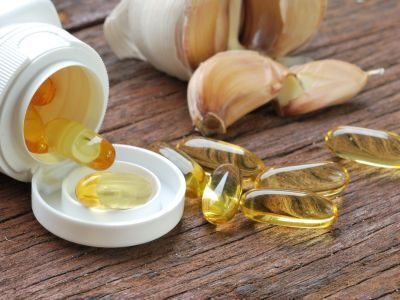
Allicin in Garlic
Garlic (Allium sativum) has been used for its medicinal properties since ancient times and is celebrated for its powerful antibacterial and antiviral properties. The compound allicin is a well-researched constituent that is partially responsible for garlic's health benefits.
- Antimicrobial Effects: Allicin exhibits broad-spectrum antimicrobial activity against bacteria, viruses, and fungi. It disrupts the cell membranes of microorganisms, leading to their death (Ankri & Mirelman, 1999).
- Cardiovascular Benefits: Allicin also has cardioprotective effects. It can lower blood pressure, reduce cholesterol levels, and prevent platelet aggregation, thus reducing the risk of cardiovascular diseases (Banerjee & Maulik, 2002).
Garlic also supports cardiovascular health by reducing blood pressure and cholesterol levels, and The antioxidant compounds in garlic may protect against cell damage and reduce the risk of chronic disease.
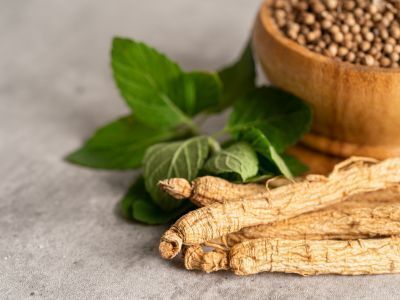
Ginsenosides in Ginseng
Ginseng (Panax ginseng), is renowned for its adaptogenic properties, which help the body resist stress and improve overall energy levels and mental clarity. A staple in Traditional Chinese Medicine, ginseng is also known for its potential to boost the immune system, enhance cognitive function, and improve physical endurance. Additionally, Panax ginseng has been studied for its anti-inflammatory and antioxidant effects, which contribute to its use in supporting general health and well-being.
- Immunomodulatory Effects: Ginsenosides, the active compounds in ginseng, have been shown to enhance the immune response. They stimulate the production of cytokines and increase the activity of natural killer cells and macrophages (Yun, 2001).
- Neuroprotective Properties: Ginsenosides also exhibit neuroprotective effects, improving cognitive function and reducing the risk of neurodegenerative diseases. They enhance the expression of neurotrophic factors and protect neurons from oxidative stress (Lee et al., 2013).
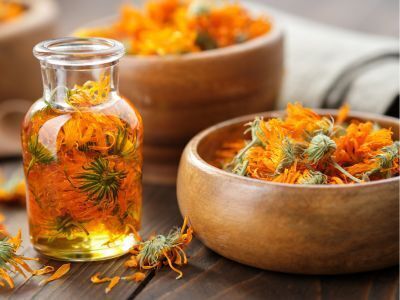
Calendula and Wound Healing
Calendula (Calendula officinalis), commonly known as marigold, has been used for centuries in traditional medicine for its wound healing properties. The flowers contain various bioactive compounds, including flavonoids, triterpenoids, and essential oils, which contribute to their therapeutic effects.
- Anti-inflammatory and Antimicrobial Properties: Calendula extracts have been shown to exhibit significant anti-inflammatory and antimicrobial activities. These properties help in reducing inflammation and preventing infection in wounds, promoting faster healing (Preethi et al., 2009).
- Wound Healing: Calendula accelerates wound healing by promoting the proliferation of fibroblasts and increasing collagen production. This facilitates the formation of new tissue and enhances the repair process (Parente et al., 2012). Studies have demonstrated that topical application of calendula ointments can improve the healing of various types of wounds, including cuts, burns, and surgical incisions (Aghbali et al., 2016).
Synergy of Plant Constituents
The therapeutic effects of plant medicines often result from the synergistic interaction of multiple constituents. This synergy can enhance the efficacy and safety of plant medicines compared to isolated compounds. For example, the combination of curcumin and other turmeric constituents may provide more potent anti-inflammatory effects than curcumin alone (Gupta et al., 2013).
Such interactions highlight the importance of using whole plant extracts in herbal medicine. The diverse range of bioactive compounds in plants works together to target multiple pathways and mechanisms in the body, leading to more comprehensive and effective healing.
Diminishing the Fear Around Plant Medicines
Despite the proven benefits of plant medicines, there is often hesitation and fear regarding their use. This fear can stem from misconceptions about safety, efficacy, and interactions with conventional treatments. By addressing these concerns with both traditional and scientific evidence and proper education, we can reduce fear and promote the safe and effective use of plant medicines.
Misconceptions About Safety
One of the most significant barriers to the acceptance of plant medicines is the misconception that they are inherently unsafe. While some plant compounds can be toxic at high doses, most are safe when used appropriately. Standardization, which involves setting specific concentrations for active ingredients, ensures the consistency and safety of herbal products (Heinrich et al., 2020).
Educational initiatives that provide accurate information about the proper use of plant medicines can help dispel fears. Healthcare providers can play a crucial role in educating patients about the benefits and risks of plant medicines, emphasizing the importance of using standardized products and consulting with professionals who have experience in utilizing plant medicine.

Efficacy Concerns
Another common fear is that plant medicines are not as effective as conventional drugs. However, numerous scientific studies have demonstrated the efficacy of plant constituents in treating various conditions. For example, curcumin in turmeric has shown significant anti-inflammatory effects, comparable to some conventional anti-inflammatory drugs (Aggarwal et al., 2007).
Highlighting the robust scientific evidence supporting the use of plant medicines can help alleviate concerns about their effectiveness. Integrative healthcare approaches that combine conventional treatments with plant medicines can provide a balanced perspective, showing that both can be effective in promoting health and healing.
Interactions with Conventional Treatments
Concerns about interactions between plant medicines and conventional treatments are valid but manageable and highly overstated and theorized. Some plant constituents can interact with drugs, altering their efficacy or causing adverse effects. However, many times this is based on a single constituent component with little to no strong in vivo (in person) evidence. Unfortunately, many healthcare providers are not adequately trained in plant medicines and lack experience outside of a theoretical interaction check to know if it is safe to combine certain plants with pharmaceuticals. This tends to lead to the practitioner simply telling their patients to discontinue any herbal supplementation rather than change the pharmaceutical recommendations.
For a deeper review into potential interactions of herbs and pharmaceutical drugs, please see our founder Donnie Yance’s blog on the subject: https://www.donnieyance.com/the-truth-about-herb-drug-interactions-an-honest-evaluation-of-the-benefits-and-risks-when-weighing-scientific-data-and-clinical-experience/
Conclusion
Plant medicines, with their rich array of bioactive compounds, offer significant potential for enhancing natural healing capabilities. The specific constituents in plants like turmeric, green tea, garlic, ginseng, and calendula have well-documented therapeutic effects, including anti-inflammatory, antioxidant, antimicrobial, immunomodulatory, and neuroprotective properties. By addressing misconceptions and fears with traditional and scientific evidence and proper education, we can promote the safe and effective use of plant medicines. Embracing the wisdom of traditional medicine, supported by rigorous scientific research and hands-on experience allows us to harness the full potential of plant medicines to support health and well-being.
Join the Mederi Center community by signing up for our email list! We send several emails a month with product promotions for patients, practical tips for healthy living, blogs written by our practitioners, information about events, and other news. You can unsubscribe at any time.
References
- Aggarwal, B. B., Sundaram, C., Malani, N., & Ichikawa, H. (2007). Curcumin: the Indian solid gold. Advances in Experimental Medicine and Biology, 595, 1-75.
- Menon, V. P., & Sudheer, A. R. (2007). Antioxidant and anti-inflammatory properties of curcumin. Advances in Experimental Medicine and Biology, 595, 105-125.
- Khan, N., & Mukhtar, H. (2007). Tea polyphenols for health promotion. Life Sciences, 81(7), 519-533.
- Yang, C. S., Wang, X., Lu, G., & Picinich, S. C. (2009). Cancer prevention by tea: animal studies, molecular mechanisms and human relevance. Nature Reviews Cancer, 9(6), 429-439.
- Ankri, S., & Mirelman, D. (1999). Antimicrobial properties of allicin from garlic. Microbes and Infection, 1(2), 125-129.
- Banerjee, S. K., & Maulik, S. K. (2002). Effect of garlic on cardiovascular disorders: a review. Nutrition Journal, 1(1), 4.
- Yun, T. K. (2001). Panax ginseng--a non-organ-specific cancer preventive? Lancet Oncology, 2(1), 49-55.
- Lee, S. M., Bae, B. S., Park, H. W., Ahn, N. G., Cho, B. G., Cho, Y. L., & Kwak, Y. S. (2013). Characterization of Korean red ginseng (Panax ginseng Meyer): history, preparation method, and chemical composition. Journal of Ginseng Research, 37(4), 370-377.
- Preethi, K. C., Kuttan, G., & Kuttan, R. (2009). Anti-inflammatory activity of flower extract of Calendula officinalis Linn. and its possible mechanism of action. Indian Journal of Experimental Biology, 47(2), 113-120.
- Parente, L. M. L., Andrade, M. A., Brito, L. A. C., Moura, V. M., Miguel, M. P., Lino-Junior, R. S., & Tresvenzol, L. M. F. (2012). Angiogenic activity of Calendula officinalis flowers. Brazilian Journal of Pharmaceutical Sciences, 48(1), 45-52.
- Aghbali, A., Hosseini, S. V., Delazar, A., Babaei, H., & Baradaran, B. (2016). Effect of Calendula officinalis extract on experimental colitis in rats. Journal of Medicinal Plants Research, 10(25), 351-355.
- Heinrich, M., Scotti, F., Booker, A., Fitzgerald, M., & Kum, K. Y. (2020). Quality and safety of herbal medical products: Regulatory systems, quality assurance, and marketing surveillance. Frontiers in Pharmacology, 11, 1020.


